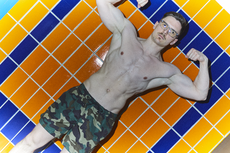Wound matrix forms cicatrix
We all carry scars, they tell us moving, tragic and inspiring stories. What would a world without scars look like? What would it be like if we lost a limb in an accident, but it could grow back on its own? We talk to scar researcher Yuval Rinkevich, Director of the Institute for Regenerative Biology and Medicine at the Helmholtz Center in Munich, about his groundbreaking project "ScarLessWorld" and a future in which we humans might be able to heal ourselves. In our C/O Vienna Books issue "PS: Scars", we document twelve scar fates in the photo series "Incisions": funny, tragic, sad, but (almost) always with a happy ending. Photography by Hilde van Mas.
Julia Bauereiß: Do you have a scar yourself?
Yuval Rinkevich: Actually, I have one right under my chin. I think many children have a lesion exactly in that spot. Mine developed while playing the game "Two Chairs", a "very intelligent" amusement (laughs). You put two chairs next to each other and all the players try to hop from one to the other. With each round, they are placed further apart to see who can jump the furthest. You can imagine how it ended for me!
With a scar!
Exactly (laughs)!
Your field is regenerative biology. Was there that one moment when you thought: “Yes, this is my thing!”?
Fibrosis is responsible for 45 percent of all deaths in the western world. For me as a scientist, it soon became clear that the question of tissue response to injury by either regeneration or scar formation is one of the most important in the research of healing human diseases.Fibrosis is the pathological manifestation of scarring and tissue hardening that occurs within our internal organs.
Was there a key moment? I think it was when I understood that scarring had only been studied in more simple cellular assays and that this was not enough to understand the complexity of human tissue scarring. Studying the regenerative abilities of animal species is really cool and interesting, but it wouldn't get us there if we want to repair human organs in the future. If we want to understand how exactly this yin and yang between scarring and recovery works.
Please explain to a layman like me what exactly you do as a scientist!
My special field of regenerative biology and medicine came into being 250 years ago after animal species were systematically researched that can completely regenerate body parts. Fins, legs, arms, or even internal organs grow back in these creatures after a loss. These include salamanders, for example, which can replace their tails themselves, or starfish, which reproduce their lost arms. Some species in the animal kingdom even have the amazing ability to rebuild themselves from just one blood vessel, these include invertebrate species such as tunicates. The question that concerns us is: Why do some animals heal injuries with the formation of scars, while others heal wounds completely or even regrow tissue and organs entirely?
"Scars are like cement which fills the gaps and holes in a wall."
It's downright magical!
This remarkable phenomenon naturally brings with it some advantages in the animal kingdom that would also be helpful for us humans. With regenerative biology and medicine, we want to understand how the human body heals and forms scars. The goal of the research field is scar- free wound healing, if not the complete regeneration of skin and organs that have been affected.
What actually is a scar, what happens to our body?
In its basic form, it is an accumulation of extracellular connective tissue. When injured, it forms as a protective reaction against external influences. If you were to explain it in architectural jargon, you could say: scars are like cement that fills the gaps and holes in a wall to protect the entire house from collapsing. In the process, the repaired area will be significantly different forever, it will be seen, but the house will remain standing!
How do scars develop?
Until now, researchers have assumed that scars develop from a special cell population, the fibroblasts. Scars were assumed to develop from fibroblasts synthesizing and secreting extracellular connective tissue on site, to build scars. However, our new findings suggest that this theory only provides a partial answer. We have found out that scars are also provided from the connective tissue surrounding the organs, from a specialized connective tissue termed fascia.
Why are fasciae relevant for scar formation?
Fascia is a form of connective tissue – you can imagine it like a gelatinous material – that surrounds, attaches and interpenetrates all our organs in a unified whole-body system. In skin, the fascia lies much deeper in the tissue, which also explains why skin scars usually form with more deep injuries. If the wound is so deep that the fascial network is also injured, we were able to determine that this fascia connective tissue material can transport itself to the wound surface. Thus, the fascia, together with the fibroblasts, provide the basic building blocks to form scars. These new findings on our part are radically changing the knowledge, thinking and future research process in this field. Physiotherapy, acupuncture, yoga and alternative medicine work a lot with fascial connective tissue. Our findings will probably also be able to support work in these areas.
"Scars are harder and stiffer than the surrounding tissue."
What is the difference between an organ scar and a skin scar?
Both types of scars are a protective reaction of the body to an injury. The crucial thing is rather where exactly the scar forms. This is more dangerous on internal organs than on the skin. I have an example for you: if a scar forms on the front of your forearm, it may not look so nice, but it doesn't affect you much. If a large scar develops on the crook of your arm, then it affects your movement considerably. After all, scars are much harder and stiffer than the surrounding tissue. Now, if scars develop on internal organs, then the function of the organ is also affected. The heart pumps many times a minute and the lungs expand and contract. If these organs now scar, they have problems pumping blood and oxygen around the body. This severe internal scarring is called fibrosis and can lead to organ failure and require a transplant.
What is the difference between a scar, a chronic wound and fibrosis?
A scar is an altered form of connective tissue, usually more compacted and stiffer than healthy tissue. Scars are reactions to acute injuries. Fibrosis is more commonly referred to as scarring of the internal organs. The cause is a disease rarely an acute injury. A chronic wound is the opposite of a scar, nothing regenerates and no scar forms. This usually happens in older people whose cells no longer react quickly enough to close a wound. This is even more problematic than scarring because a chronic wound can really have a very negative impact on a person's state of health and carries risks.
What do salamanders and embryos have in common in terms of scarring?
Both can actually regenerate wounds without forming scars. This phenomenon is somewhat more pronounced in salamanders, as they are known to be able to regrow entire limbs. Surprisingly, similar regeneration processes as in salamanders have been observed in human embryos. Embryos or newborns also have the ability to regenerate tissue and even organs. For example, there are cases where the fingertips of newborns had to be amputated and they were able to regenerate the distal tips without scarring, that's fascinating!
There is obviously a transitional stage where we still have animal abilities of regeneration that we then lose as humans ...
Exactly, the more anatomical complexity we reach, the more we become human. The regenerative abilities are then hardly present anymore. From foetal to adult life, we undergo a phenotypic change, which happens around the last third of pregnancy. This change takes place on the outside as well as on the internal organs. This does not happen suddenly, but each organ has a different point in time when the ability to regenerate stops and scarring begins.
"Wounds heal better depending on the region of the body and age."
Do all areas of the body scar equally?
Wounds heal better – or worse – depending on the region of the body and age. In the oral cavity or the genital area, no scars can develop from injuries, even in adults. We have found an explanation for this: Fibroblasts are not just one type of cell, but many different ones. Some of these fibroblast cells have the ability to regenerate and others do not. The regeneration cells are found more often in embryos and young people, while in adults it is more the scar-forming cell types.
Couldn't you transfer the regenerative abilities of embryos to adult bodies?
That might be possible with future research, but such experiments on humans and embryos are not allowed. We can only conduct research on model organisms that resemble human skin and mimic certain diseases, but we are already making great progress in this area. It will probably be a while before we can really transfer the results to patients.
Why does the belly button as a physiological scar not affect us negatively?
After all, it is only a small area that is not particularly relevant for certain bodily functions. Besides, the development of the belly button is a process during embryonic development. The body therefore sees it as healthy tissue and not as a diseased part of the body. Belly button piercing however does lead to scars in many cases.
"We have already been able to stop scarring altogether."
How could your research results change the future of medicine, what could be possible?
I think this is the next level of medicine: real regeneration, real healing and real renewal of human tissue. Not only we with the research project "ScarLessWorld", but also many other laboratories are working hard to hopefully make this idea a reality soon. After all, regenerative biology and medicine promises to cure so many diseases, for example pulmonary fibrosis, where the lungs scar and this cannot be reversed. It would mean an all-changing breakthrough for medicine, its ways of thinking and its possibilities.
That would be truly groundbreaking! Could it be that in the future people could regenerate not only skin but also bones or entire limbs?
This still sounds very utopian. We are in fact not only researching the skin, we are also investigating the phenomenon of scar formation and regeneration on the whole body. We have already achieved the most success in skin research on our model organisms. We have already been able to completely stop scarring and prevent the occurrence of fibrosis and even return the tissue to its normal and healthy state. That is already a good indicator of what could be possible medically in the future: So definitely the regeneration of skin inside and outside the body, everything else will be seen. We are on the right track with our research.
Thank you very much for the interview!


